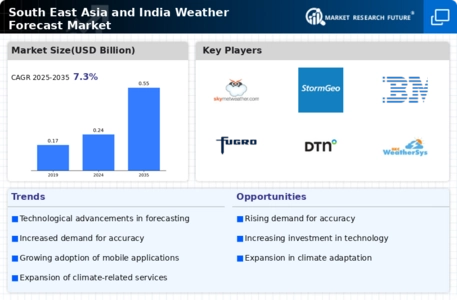Market Trends
Key Emerging Trends in the South East Asia and India Weather Forecast Market
The weather forecast market in South East Asia and India is witnessing significant growth and evolving trends due to various factors such as increasing urbanization, technological advancements, and the growing importance of accurate weather prediction for various sectors. One prominent trend in this market is the rising demand for real-time weather information and advanced forecasting services. With the expansion of industries such as agriculture, aviation, maritime, and renewable energy in the region, there is a growing need for timely and precise weather forecasts to support decision-making, enhance operational efficiency, and mitigate risks associated with weather-related events.
Moreover, technological innovations in meteorological instrumentation, data analytics, and modeling techniques are driving advancements in weather forecasting capabilities. The deployment of weather monitoring networks, satellite imaging systems, and weather prediction models equipped with artificial intelligence and machine learning algorithms enables meteorologists to analyze vast amounts of data and generate more accurate and reliable forecasts. Additionally, the proliferation of mobile and web-based weather applications provides individuals and businesses with access to up-to-date weather information, customized forecasts, and severe weather alerts, enhancing awareness and preparedness for adverse weather conditions.
Furthermore, the adoption of weather forecasting services is gaining traction across various industries in South East Asia and India. In agriculture, accurate weather forecasts play a crucial role in crop planning, irrigation management, and pest control, helping farmers optimize yields and minimize losses. In the aviation sector, precise weather predictions are essential for flight planning, route optimization, and operational safety, particularly in regions prone to tropical storms and monsoon seasons. Similarly, maritime industries rely on weather forecasts for vessel routing, offshore operations, and port management to ensure maritime safety and minimize disruptions due to adverse weather conditions.
Additionally, the renewable energy sector is increasingly integrating weather forecasting into energy production and grid management strategies. Wind and solar power generation are highly dependent on weather conditions, making accurate weather forecasts essential for optimizing energy output, scheduling maintenance activities, and managing grid stability. As South East Asia and India continue to invest in renewable energy infrastructure and transition towards cleaner and sustainable energy sources, the demand for weather forecasting services tailored to the needs of the renewable energy sector is expected to grow.
However, despite the opportunities and advancements in the weather forecast market, several challenges persist, including data quality issues, forecasting accuracy, and infrastructure limitations. Inaccurate or incomplete weather data can undermine the reliability of forecasts and impact decision-making processes, highlighting the importance of data quality assurance and validation procedures. Moreover, predicting extreme weather events such as typhoons, cyclones, and heavy rainfall remains a complex challenge due to the dynamic nature of atmospheric phenomena and the limited predictability of certain weather patterns.
Furthermore, infrastructure constraints and funding limitations pose challenges for expanding weather monitoring and forecasting capabilities in South East Asia and India. Developing and maintaining weather observation networks, upgrading meteorological infrastructure, and investing in research and development initiatives require substantial resources and long-term commitments from governments and stakeholders. Addressing these challenges will be crucial for enhancing the resilience and adaptive capacity of communities and industries in the face of climate variability and extreme weather events.

















Leave a Comment